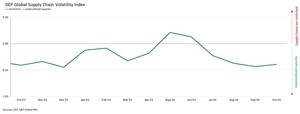Demand for raw materials and components weakens sharply in Europe and North America in June, Indicating greater risk to the economy heading into the second half of 2023: GEP Global Supply Chain Volatility Index
- Worldwide supply chain spare capacity rises for the third successive month, remaining at the highest level since zenith of the pandemic in May 2020
- Demand in Asia, led by India, is holding up better than in Europe and North America, highlighting divergence in growth between Western and Eastern economies
- Global supply shortages fell to their lowest since January 2020 and companies operated with low levels of inventories following months of stock drawdowns
CLARK, N.J, July 14, 2023 /PRNewswire/ -- The GEP Global Supply Chain Volatility Index — a leading indicator tracking demand conditions, shortages, transportation costs, inventories and backlogs based on a monthly survey of 27,000 businesses — recorded -0.26 in June (vs. -0.28 in May), marking a third successive month of excess global supplier capacity. Today's figure highlights the complete reversal in global supply chain frictions compared to a year ago, when GEP's index stood at 3.53.
In June, a key finding was the worsening of global demand for raw materials, commodities and components, specifically in Europe and North America, signalling a deteriorated outlook for manufacturing as borrowing costs rise, with risks of spillover effects to the wider economy intensifying. This in turn led excess capacity at suppliers operating in these regions to rise rapidly and by a larger degree than seen in May.
In contrast, input demand in Asia is showing greater resilience. Purchasing activity across the region is broadly tracking in line with its historical average, with pockets of strength in some Eastern markets led by India, one of the fastest-growing major economies so far in 2023.
Commenting on the June data, Joel Johnson, vice president, supply chain consulting, GEP, said: "Weakening demand for components and raw materials in the Western economies, low levels of inventory and excess global supplier capacity suggest that storm clouds are gathering. The softening of demand in the manufacturing sector in the last few months is a leading indicator that the broader economy in the Western hemisphere will slow in the second half of 2023. It's a perfect time for companies' procurement to re-negotiate terms for 2024 and 2025 with suppliers.
June 2023 Key Findings:
- DEMAND: Global demand for raw materials, commodities and components weakened to the greatest degree since January, driven by sharper deteriorations in Europe and North America.
- INVENTORIES: Reports from businesses of safety stockpiling were only just above their long-run average in June, indicating little desire among companies to hold excess inventory.
- MATERIALS SHORTAGES: Reports of item shortages fell once again in June and are now at their lowest level since January 2020.
- LABOR SHORTAGES: Reports of backlogs directly due to a lack of employees are historically low.
- TRANSPORTATION: Global transportation costs fell further below their historical average, significantly easing inflationary pressures on companies.
REGIONAL SUPPLY CHAIN VOLATILITY
Supplier capacity in Asia also remains underutilized, but to a much lesser extent than in Western economies.
- NORTH AMERICA: Declined to -0.85 in June from -0.70 in May as input demand weakened notably.
- EUROPE: Declined to -0.67 in June from -0.58 in May, as input demand declined in lockstep with North America.
- U.K.: Remained subdued at -0.60 in June but relatively unchanged from -0.66 in May.
- ASIA: Bucked the global downward trend at -0.17 in June versus -0.18 in May as region shows more resilience.
For more information, visit www.gep.com/volatility
Note: Full historic data dating back to January 2005 is available for subscription. Please contact [email protected].
The next release of the GEP Global Supply Chain Volatility Index will be 8 a.m. ET, August 14, 2023.
ABOUT THE GEP GLOBAL SUPPLY CHAIN VOLATILITY INDEX
The GEP Global Supply Chain Volatility Index is produced by S&P Global and GEP. It is derived from S&P Global's PMI™ surveys, sent to companies in over 40 countries, totaling around 27,000 companies. The headline figure is a weighted sum of six sub-indices derived from PMI data, PMI Comments Trackers and PMI Commodity Price & Supply Indicators compiled by S&P Global.
- A value above 0 indicates that supply chain capacity is being stretched and supply chain volatility is increasing. The further above 0, the greater the extent to which capacity is being stretched.
- A value below 0 indicates that supply chain capacity is being underutilized, reducing supply chain volatility. The further below 0, the greater the extent to which capacity is being underutilized.
For more information, click here.
About GEP
GEP® delivers transformative supply chain solutions that help global enterprises become more agile and resilient, operate more efficiently and effectively, gain competitive advantage, boost profitability and increase shareholder value. Fresh thinking, innovative products, unrivaled domain expertise, smart, passionate people — this is how GEP SOFTWARE™, GEP STRATEGY™ and GEP MANAGED SERVICES™ together deliver supply chain solutions of unprecedented scale, power and effectiveness. Our customers are the world's best companies, including more than 550 Fortune 500 and Global 2000 industry leaders who rely on GEP to meet ambitious strategic, financial and operational goals. To learn more, visit www.gep.com.
About S&P Global
S&P Global (NYSE: SPGI) S&P Global provides essential intelligence. We enable governments, businesses and individuals with the right data, expertise and connected technology so that they can make decisions with conviction.
Media Contacts |
|
Derek Creevey |
Joe Hayes |
Director, Public Relations |
Principal Economist |
GEP |
S&P Global Market Intelligence |
T 646.276.4579 |
T: +44-1344-328-099 |
Email: [email protected] |
|
SOURCE GEP

WANT YOUR COMPANY'S NEWS FEATURED ON PRNEWSWIRE.COM?
Newsrooms &
Influencers
Digital Media
Outlets
Journalists
Opted In




Share this article